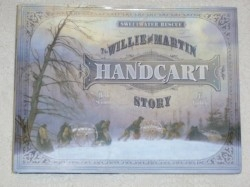
Sweetwater Rescue
The Willie and Martin Handcart Story
“The way to have a warm sleeping place was this—sweep away the ashes of the campfire and lay your bed on the spot where the fire had been built,” wrote Englishman John Jacques, traveling the Mormon Trail. “In the morning the same spot was found to be the easiest place in which to dig a grave to bury the night’s dead.”
150 years ago, Jacques was one of nearly 1,800 Mormon faithful from Europe who traveled on foot from Iowa to Salt Lake City; small handcarts carried any belongings. Of the five church-sanctioned groups that left in 1856, the last two—the Willie and Martin handcart companies, named for the two men in charge and consisting of nearly 1,000 persons—got a late start. Because of the delay, they encountered severe weather, losing more than 200 people along the trail.
Church leaders sent men out to rescue the stranded immigrants; they encountered the first company along Wyoming’s Sweetwater River. The author has won awards for her writing and screenplays; she wrote the script for the PBS documentary American Prophet: The Story of Joseph Smith. This book is a companion piece for another film, to be shown on PBS in late October.
The book contains illustrations by Utah-area artists—some descended from the handcart pioneers themselves—depicting the landscapes and people in the story. The yellow treeless rolling plains and puffy white clouds hanging low from the brilliant blue sky provide the background for settlers traveling single file in David Meikle’s painting, “Heading West From Council Bluffs.” Another illustration portrays families navigating their carts through one of the numerous rivers and streams that the pioneers crossed, the lushness of the trees on the banks the color of Indian summer. Black-and-white photos of many of the principals are also included, personalizing the excerpts from journals and diaries.
The pilgrims endured terrible hardships along the trail. As they floundered forward in the wilderness, “one woman recalled her husband putting his arm around her as they went to bed. ‘I am done.’ Those were his last words.”
Wrote Captain George Grant when his rescue party discovered the Martin Company: “You can imagine between 500 and 600 men, women, and children, worn down by drawing handcarts through snow and mud, fainting by the wayside, falling chilled by the cold, children crying, their limbs stiffened by the cold, their feet bleeding.”
By 1860, five additional handcart companies had made the trip, with major changes made as a result of the painful lessons learned from the Sweetwater event, significant in Mormon history.
Landscape that whizzes by in a blur today—“the prairie heat, wind, cold, and snow, the frigid river crossings, the sandy plains, and frozen Rocky Mountains are but a backdrop to this saga of heroic proportion.”
Disclosure: This article is not an endorsement, but a review. The publisher of this book provided free copies of the book to have their book reviewed by a professional reviewer. No fee was paid by the publisher for this review. Foreword Reviews only recommends books that we love. Foreword Magazine, Inc. is disclosing this in accordance with the Federal Trade Commission’s 16 CFR, Part 255.
